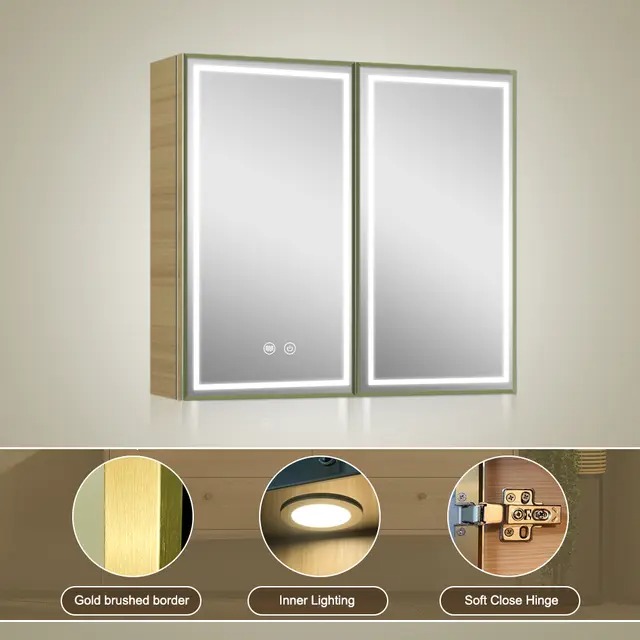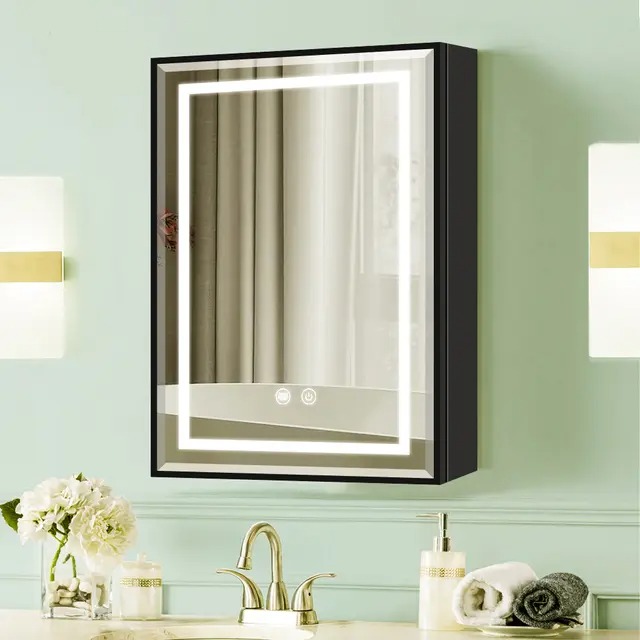

Views: 216 Author: Site Editor Publish Time: 2025-09-26 Origin: Site











A mirror cabinet is one of the most functional additions to a bathroom, offering both reflective surfaces and hidden storage. Many homeowners wonder whether a mirror cabinet can be recessed into the wall for a sleeker look and space efficiency. Recessing a mirror cabinet is not only possible but also one of the most popular choices in modern bathroom renovations. It creates a flush, built-in appearance that enhances aesthetics while maintaining practicality. However, achieving this requires careful planning, an understanding of wall structures, and proper installation techniques.
Recessing a mirror cabinet means embedding it into the wall cavity so that the cabinet sits flush with the wall surface rather than protruding outward. Unlike surface-mounted options, a recessed mirror cabinet requires cutting into drywall, confirming the depth between studs, and ensuring no plumbing or electrical lines interfere. This creates a seamless appearance but introduces structural and technical factors that must be evaluated. Essentially, the wall becomes part of the cabinet’s housing, transforming both storage and design potential.

The appeal of a recessed mirror cabinet lies in its combination of form and function. Some of the main advantages include:
Space Saving: Ideal for compact bathrooms where every inch matters.
Minimalist Aesthetics: Creates a clean, flush look with no bulky projection.
Increased Storage: Provides storage without sacrificing room space.
Enhanced Safety: Reduces protrusion risks, especially in narrow bathroom layouts.
Customization Potential: Can be aligned with tile lines, lighting, or double vanities for a polished effect.
| Benefit | Recessed Mirror Cabinet | Surface-Mounted Cabinet |
|---|---|---|
| Space Efficiency | Flush with wall, no obstruction | Extends into room |
| Aesthetics | Sleek, built-in design | Bulkier, noticeable edges |
| Storage | Equal storage, hidden depth | Equal storage, visible bulk |
| Installation Complexity | Requires wall modification | Easier, minimal wall prep |
Before cutting into any wall, several critical factors should be addressed:
Wall Depth: Most recessed mirror cabinets require at least 4 inches of wall cavity depth.
Stud Placement: Cabinets must fit between studs or require modification to framing.
Plumbing and Electrical Lines: Many bathroom walls contain pipes or wiring that limit cabinet placement.
Moisture Resistance: Bathrooms generate humidity; proper sealing and moisture-resistant drywall are essential.
Load-Bearing Walls: Recessing into load-bearing walls requires extra reinforcement and may not always be feasible.
| Consideration | Why It Matters |
|---|---|
| Wall Depth | Determines if cabinet can be recessed at all |
| Stud Spacing | Affects installation location and width |
| Utilities Behind Wall | Avoids costly relocations |
| Structural Integrity | Ensures safe modifications |
| Moisture Control | Prevents future damage and mold |
For homeowners and contractors alike, following a structured approach ensures safe and effective installation.
Choose a mirror cabinet that specifies both surface and recessed installation options. Standard sizes are available, but custom units can maximize storage.
Use a stud finder to map studs, pipes, and wiring. Bathrooms often have limited wall space, so location selection is crucial.
Once confirmed, carefully cut into the drywall using a reciprocating saw or multi-tool. The cut must match cabinet dimensions for a snug fit.
If studs interfere, additional framing or supports may need to be added. Reinforce the cavity so the cabinet sits securely.
Slide the cabinet into the cavity and screw it into framing brackets. Ensure it is level before tightening fully.
Seal edges with caulk, especially in humid areas, and finish with paint or tile alignment for a seamless look.

While the finished result is elegant, recessing a mirror cabinet is not always straightforward. Potential issues include:
Insufficient Wall Depth: Thin walls in older homes may not accommodate standard cabinets.
Unexpected Pipes/Wires: Relocating utilities adds cost and complexity.
Framing Adjustments: Cutting into load-bearing walls requires professional reinforcement.
Moisture Risks: Improper sealing can lead to condensation inside the wall cavity.
Accessibility Issues: Recessing may reduce cabinet depth in very shallow walls, limiting storage.
In such cases, semi-recessed or surface-mounted solutions may be better alternatives.
Deciding whether to recess your mirror cabinet depends on your bathroom layout, wall conditions, and personal preference.
| Feature | Recessed Mirror Cabinet | Surface-Mounted Mirror Cabinet |
|---|---|---|
| Appearance | Flush, modern look | Traditional, protruding design |
| Space Use | Maximizes floor area | Takes up wall projection |
| Installation | Complex, requires cutting wall | Simple, mounts directly |
| Cost | Higher due to labor | More affordable |
| Flexibility | Limited to wall depth/space | Can be placed on almost any wall |
If aesthetics and space optimization are priorities, recessed is best. For quick installation and flexibility, surface-mount remains practical.
Recessed mirror cabinets are not limited in style. Options include:
Frameless Designs: Minimalist look, ideal for modern bathrooms.
Framed Cabinets: Add character and match existing décor.
Double or Triple Door Units: Perfect for shared bathrooms.
Integrated Lighting: LED-lit cabinets enhance both function and mood.
Custom-Built Cabinets: Tailored to fit unique wall conditions and personal design choices.
These variations allow homeowners to achieve both practical storage and an aesthetic upgrade.
Recessed designs elevate bathroom aesthetics, save space, and offer seamless integration. While the process involves more planning and effort compared to surface-mounted alternatives, the results are often worth the investment. Whether you choose a DIY route or hire a professional, understanding the requirements ensures you achieve both style and functionality with your mirror cabinet.
Q1: Can any mirror cabinet be recessed?
Not all models are designed for recessing. Always check product specifications before purchase. Some are dual-mount (surface and recessed), while others are surface-only.
Q2: How deep does a wall need to be for a recessed mirror cabinet?
Most require at least 4 inches of depth between drywall and studs, though custom cabinets can be designed for shallower walls.
Q3: Can I recess a mirror cabinet into a wall with plumbing?
It is generally not recommended unless pipes can be relocated, which significantly increases cost and complexity.
Q4: Are recessed mirror cabinets more expensive?
The cabinet itself may be similarly priced to surface-mounted units, but labor and wall modification add to the overall cost.
Q5: Do recessed mirror cabinets reduce storage capacity?
No, they typically maintain the same storage capacity as surface-mounted options—the difference is in wall integration, not storage volume.